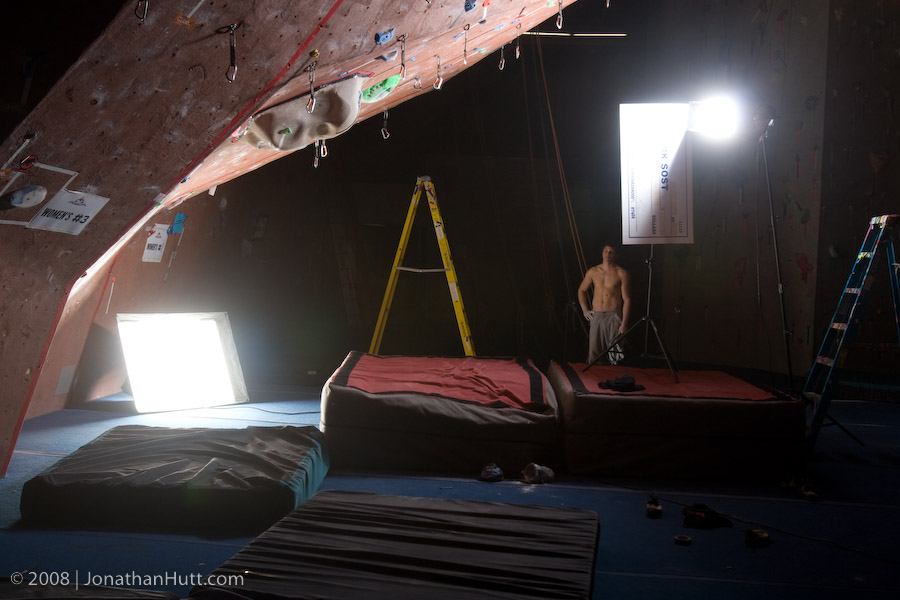Here's a piece I wrote for Strobist sometime last year, but I figure it's pretty appropriate for the conversation. Enjoy!
As many of the incoming members to this group already know, one of the most important ways to add drama and visual impact to a photograph is through the use of lighting. I imagine many of the photographers coming into this new group are coming in from the Strobist group and very possibly new to the whole idea of strobe lighting. I'm going to describe a bit of the thought process that goes into conceptualizing a photograph, and then deciding HOW to light the subject, based on the final concept dreamed up.
When I first got into this whole lighting thing, before Strobist even existed, (but not too long ago... I'm still a young'un), I didn't know very much at all about actually designing light. I just blasted my subject with light from an arbitrary angle, usually 45 degrees off the camera's axis, and only because that's what I'd seen once or twice in a book. Or something. As I shot more and more and really began to study the effects of lighting, I began to see how light and shadow interact, how they effect the dynamic of a photograph, and how to best use them to create compelling imagery. Being able to instinctively see the light that will eventually shoot forth for 1/3000 of a second is the keystone to becoming a competent studio photographer. Of course, this holds true both in the studio or on location, with large, powerful studio lighting, or small and light Vivitar 285's.
I'd like to present one of my recent photos. This was shot as a personal piece for stock and more importantly, for pure enjoyment.
In climbing, there's a move called a "dyno" - short for "dynamic." Essentially, it's a "dynamic" jump which allows you to reach a hold that you would otherwise not be able to reach because it's too far away. Dynos require a substantial amount of strength and athleticism - I wanted to showcase the jump, the climber's feet swinging in mid air, and the intense level of overall body strength required to pull off the move. I grabbed my insanely strong buddy Simon to help me pull it off.
Set up shot:
As you can see, this was a 2-light shot. I was standing on the yellow ladder, shooting towards the camera's current perspective. Down low you see a large 3'x4' softbox. This illuminated the wall (to give context) and obviously, lit Simon as well. The second softbox (up high) is a 1'x3' strip box positioned horizontally directly behind Simon and gives the gorgeous highlight (if I do say so myself) along his shoes. I set it up this way both for 'flair' and to separate his black shoes from the dark interior of the climbing gym.
The large white fake check was only added as an afterthought. I was getting substantial lens flare from the stripbox and needed a flag, but I had left all my grip equipment back at the studio and needed to improvise. I pulled the fake check off the wall (with the permission of management, of course) and gaffer taped it to another light stand. Worked like a charm

The whole point of this: I could just as easily have been lazy and put up the key light on a stand next to me on the ladder, but that wouldn't have illuminated the rest of wall as evenly. In fact, that's where I initially positioned it. However, I was unhappy with my results and spent a bit of time searching for a better light position until I found what's seen in the above shot. Had the strip box been positioned anywhere but directly behind him, the characteristics of the light would have been totally different and not given the smooth highlight along his soles and legs, but a harsher rim light, which I didn't want.
Actually having a purpose and a plan for your lighting is absolutely essential to turning out polished work. Learn the behaviors of your modifiers inside and out so you can accurately predict how each will shape the light... don't guess and check during a live shoot. Once you bore your model (or in this case, exhaust your climber), you've probably "lost the battle."
I hope this kicks off a great new group and I'm hoping to learn even more than I'm planning to share. Happy shooting!
-Jonathan
(Oh, for what it's worth, those were Dynalite 4040 heads inside Chimera softboxes, each running off an individual Dynalite 1000WS pack).




















